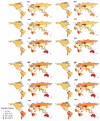The Effect of Human Development Index on Obesity Prevalence at the Global Level: A Spatial Analysis
- PMID: 37551189
- PMCID: PMC10404321
- DOI: 10.18502/ijph.v52i4.12456
The Effect of Human Development Index on Obesity Prevalence at the Global Level: A Spatial Analysis
Abstract
Background: Obesity is one of the major public health concerns, and its prevalence is increasing worldwide. This study aimed to investigate the effect of human development index on the prevalence of obesity across 152 countries.
Methods: Country-level data on obesity prevalence and its influencing variables related to 152 countries were obtained during 2000-2019 from several sources. A Spatial Bayesian Hierarchical model was employed in this research, and the analyses were performed using R statistical software (version 3.6.1).
Results: We found a positive relation between HDI and obesity prevalence, in such a way if low HDI countries advance to high HDI countries, the obesity rate is expected to increase significantly by 7.45%. Moreover, the association between obesity prevalence and the percentage of people aged 40-59 (β=0.07), urbanization rate (β=0.11), percentage of internet users (β=0.01), percentage of alcohol users (β=0.16), milk consumption per capita (β=0.15) and Percentage of depression (β=0.58) was significantly positive. Conversely, per capita consumption of fruits and vegetables (β=-0.15), and smoking rate (β=-0.02) was negatively associated with obesity prevalence.
Conclusion: The prevalence of obesity is growing across all countries, especially in the countries with high and very high HDI. Therefore, policymakers must also pay attention to the negative effects of development when trying to improve the welfare of society.
Keywords: Human development index; Lifestyle factors; Obesity; Sociodemographic factors.
Copyright © 2023 Shirvani Shiri et al. Published by Tehran University of Medical Sciences.
Conflict of interest statement
Conflict of Interest The authors declare that there is no conflict of interests.
Figures



Similar articles
-
Association of Socioeconomics With Prevalence of Visual Impairment and Blindness.JAMA Ophthalmol. 2017 Dec 1;135(12):1295-1302. doi: 10.1001/jamaophthalmol.2017.3449. JAMA Ophthalmol. 2017. PMID: 29049446 Free PMC article.
-
Worldwide Distribution, Risk Factors, and Temporal Trends of Testicular Cancer Incidence and Mortality: A Global Analysis.Eur Urol Oncol. 2022 Oct;5(5):566-576. doi: 10.1016/j.euo.2022.06.009. Epub 2022 Jul 19. Eur Urol Oncol. 2022. PMID: 35863988
-
Socio-economic development, level of urbanization and consumption of selected food products as factors in the prevalence of overweight and obesity among youths and young adults in Poland.Ann Agric Environ Med. 2020 Mar 17;27(1):139-145. doi: 10.26444/aaem/112373. Epub 2019 Sep 23. Ann Agric Environ Med. 2020. PMID: 32208593
-
Association between intra-operative cardiac arrest and country Human Development Index status: a systematic review with meta-regression analysis and meta-analysis of observational studies.Anaesthesia. 2021 Sep;76(9):1259-1273. doi: 10.1111/anae.15374. Epub 2021 Jan 29. Anaesthesia. 2021. PMID: 33512708
-
Meat, fruit, and vegetable consumption in sub-Saharan Africa: a systematic review and meta-regression analysis.Nutr Rev. 2021 May 12;79(6):651-692. doi: 10.1093/nutrit/nuaa032. Nutr Rev. 2021. PMID: 32556305
Cited by
-
Projected epidemiological trends and burden of liver cancer by 2040 based on GBD, CI5plus, and WHO data.Sci Rep. 2024 Nov 15;14(1):28131. doi: 10.1038/s41598-024-77658-2. Sci Rep. 2024. PMID: 39548154 Free PMC article.
-
Worldwide patterns and trends in ovarian cancer incidence by histological subtype: a population-based analysis from 1988 to 2017.EClinicalMedicine. 2024 Dec 6;79:102983. doi: 10.1016/j.eclinm.2024.102983. eCollection 2025 Jan. EClinicalMedicine. 2024. PMID: 39720606 Free PMC article.
-
Bridging the gap in obesity research: A consensus statement from the European Society for Clinical Investigation.Eur J Clin Invest. 2025 Aug;55(8):e70059. doi: 10.1111/eci.70059. Epub 2025 May 15. Eur J Clin Invest. 2025. PMID: 40371883 Free PMC article. Review.
-
National and subnational trends in obesity prevalence in Iran: a Spatiotemporal study with future predictions.Sci Rep. 2025 May 21;15(1):17664. doi: 10.1038/s41598-025-01531-z. Sci Rep. 2025. PMID: 40399344 Free PMC article.
-
Association of oral contraceptives and risk of endometrial cancer: A systematic review and meta-analysis.Acta Obstet Gynecol Scand. 2025 Apr;104(4):591-603. doi: 10.1111/aogs.15043. Epub 2025 Feb 21. Acta Obstet Gynecol Scand. 2025. PMID: 39981760 Free PMC article.
References
-
- World Health Organization ( 2018). Obesity and overweight. https://www.who.int/news-room/fact-sheets/detail/obesity-and-overweight
-
- Hosseinpanah F, Mirbolouk M, Mossadeghkhah A, et al. ( 2016). Incidence and potential risk factors of obesity among Tehranian adults. Prev Med, 82: 99–104. - PubMed
LinkOut - more resources
Full Text Sources
